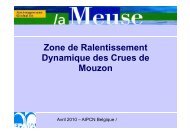PIANC E-Magazine - PIANC AIPCN welcome
PIANC E-Magazine - PIANC AIPCN welcome
PIANC E-Magazine - PIANC AIPCN welcome
Create successful ePaper yourself
Turn your PDF publications into a flip-book with our unique Google optimized e-Paper software.
Stability of Crown Walls of Cube and Cubipod<br />
Armoured Mound Breakwaters<br />
by<br />
JORGE MOLINES<br />
Laboratory of Ports and Coasts<br />
Universidad Politécnica de Valencia<br />
Isabel la Catolica 33 Alcoy (Alicante)<br />
Spain<br />
Tel.: + 34 620 52 86 81<br />
E-mail: jormollo@hotmail.com<br />
Winner of the Modesto Vigueras Award 2010 (Spain)<br />
KEY WORDS<br />
Crown Wall Forces, Crown Wall Stability, Breakwater,<br />
Crown Wall Sliding, Cubipod<br />
MOTS-CLEFS<br />
Efforts sur les murs de couronnement, stabilité<br />
des murs de couronnement, glissement des murs<br />
de couronnement, Cubipod<br />
1. INTRODUCTION<br />
Breakwaters can generally be divided into two<br />
types: vertical and mound breakwaters. The former<br />
reflect the wave energy, with the associated<br />
problems for navigation, but they are cheaper and<br />
more respectful of the environment than the mound<br />
ones. The latter absorb part of the wave energy,<br />
resisting wave action mainly by wave breaking.<br />
Normally, mound breakwaters are crowned with a<br />
concrete superstructure resting on the mound layer<br />
and are partially protected by the armour layer.<br />
The aim is to reduce the amount of concrete used<br />
in armour layers and increase the crest freeboard<br />
while decreasing cost. Crown walls are attacked<br />
by wave impact and earth armour layer pressure,<br />
the former being the most important one due to<br />
the higher value.<br />
Initially, the main layer of mound breakwaters<br />
consisted of quarrystone. As demand for space<br />
in ports grew, it became necessary to place the<br />
breakwaters deeper. At greater depths, no quarry<br />
could provide heavy enough quarrystone, so<br />
prefabricated elements of concrete such as the<br />
Cube, the Tetrapode (1950) or the Dolo (1963)<br />
appeared.<br />
In a mound breakwater there are different types<br />
of failure modes, as shown in Figure 1 by Bruun<br />
(1985): extraction of armour units, overtopping,<br />
erosion of the toe, etc. There are four common<br />
types of failure affecting the crown wall:<br />
1. Sliding is the most common failure mode. It<br />
happens when the horizontal force is greater<br />
than the friction resistance, which can be altered<br />
by ascending pressures.<br />
2. Overturning happens when the unstabilising<br />
moments are larger than the stabilising ones.<br />
3. Cracking refers to the deterioration of the material<br />
throughout its lifetime.<br />
4. Geotechnical failure is the failure of the foundations.<br />
It is caused when the load transmitted<br />
is higher than the load of collapse of the foundations.<br />
Failures modes 2 (overturning) and 3 (cracking)<br />
are easily solved by the proper design of the crown<br />
wall geometry. Failure mode 4 (geotechnical failure)<br />
is related to the foundation soils rather than<br />
to the crown wall design; therefore, sliding is the<br />
most typical critical failure, since it requires building<br />
the crown wall with sufficient weight.<br />
29<br />
<strong>PIANC</strong> E-<strong>Magazine</strong> n° 144, November/novembre 2011




